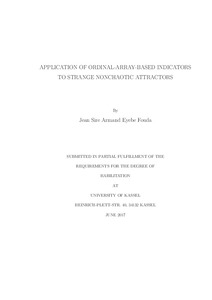| dc.date.accessioned | 2017-08-10T11:18:35Z | |
| dc.date.available | 2017-08-10T11:18:35Z | |
| dc.date.issued | 2017-06-12 | |
| dc.identifier.uri | urn:nbn:de:hebis:34-2017081053247 | |
| dc.identifier.uri | http://hdl.handle.net/123456789/2017081053247 | |
| dc.description.sponsorship | Alexander von Humboldt foundation | ger |
| dc.language.iso | eng | |
| dc.publisher | Universität Kassel | ger |
| dc.rights | Urheberrechtlich geschützt | |
| dc.rights.uri | https://rightsstatements.org/page/InC/1.0/ | |
| dc.subject | Ordinal pattern | eng |
| dc.subject | Complexity | eng |
| dc.subject | Chaos | eng |
| dc.subject | Strange nonchaotic attactor | eng |
| dc.subject.ddc | 004 | |
| dc.title | Applicability of ordinal-array-based indicators to strange nonchaotic attractors | eng |
| dc.type | Habilitation | |
| dcterms.abstract | Time series are useful for modeling systems behavior, for predicting some events (catastrophes, epidemics, weather, ...) or for classification purposes (pattern recognition, pattern analysis). Among the existing data analysis algorithms, ordinal pattern based algorithms have been shown effective when dealing with simulation data. However, when applied to quasi-periodically forced systems, they fail to detect SNA and tori as regular dynamics. In this work we address this concern by defining ordinal array (OA) based indicators, namely the OA complexity (OAC) and three OA asymptotic growth indices: the periodicity, the quasi-periodicity and the non-regularity index. OA growth indices allow to clearly distinguish between periodic and quasi-periodic dynamics, which is not possible with the existing ordinal pattern-based entropy and complexity measures. They clearly output integer values for periodic dynamics and non-integer values for SNA and quasi-periodic dynamics. SNA and quasi-periodic dynamics are distinguished from weakly chaotic dynamics by the sign of the non-regularity index: it is positive for chaotic data and negative for regular dynamics. A further test based on the dependence of the OA growth indices on the time series length allows us to distinguish between tori and SNA. Moreover, by defining the upper limits of the OA growth indices for purely random data, a classification between deterministic and stochastic data is achieved. The non-regularity index may also be used as a complexity measure for non-regular dynamics by considering large time series length, but the OAC still provides a better estimate of the complexity for moderate data length. So, OA growth indices are useful for determining the nature of the data series (periodic, quasi-periodic, chaotic or stochastic), while the OAC allows us to estimate the corresponding complexity. The four indicators thus defined constitute a complete tool for nonlinear data analysis applicable to any type of time series. | eng |
| dcterms.accessRights | open access | |
| dcterms.creator | Eyebe Fouda, Jean Sire Armand | |
| dc.contributor.corporatename | Kassel, Universität Kassel, Fachbereich Mathematik und Naturwissenschaften, Institut für Mathematik | |
| dc.contributor.referee | Koepf, Wolfram (Prof. Dr.) | |
| dc.contributor.referee | Kneiss, Dorothee | |
| dc.contributor.referee | Rück, Georg (Prof. Dr.) | |
| dc.contributor.referee | Keller, Karstern (Dr.) | |
| dc.contributor.referee | Bilbault, Jean-Marie (Prof. Dr.) | |
| dc.subject.msc | 62-07 | ger |
| dc.subject.pacs | 02 | ger |
| dc.subject.pacs | 05 | ger |
| dc.subject.swd | Indikator | ger |
| dc.subject.swd | Komplexität | ger |
| dc.subject.swd | Algorithmus | ger |
| dc.subject.swd | Seltsamer Attraktor | ger |
| dc.date.examination | 2017-06-12 | |

